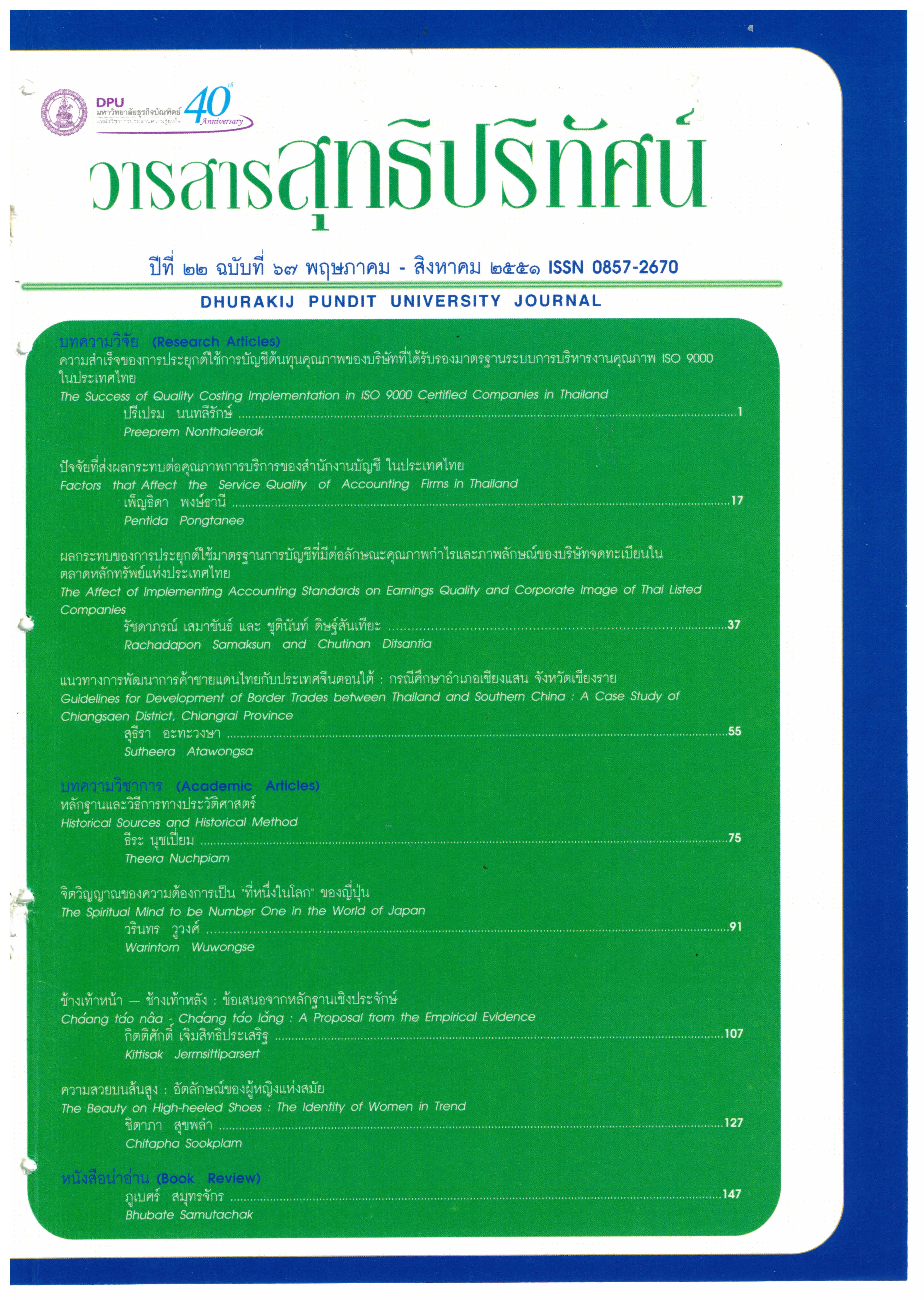ความสำเร็จของการประยุกต์ใช้การบัญชีต้นทุนคุณภาพของบริษัทที่ได้รับรองมาตรฐานระบบการบริหารงานคุณภาพ ISO 9000 ในประเทศไทย
คำสำคัญ:
การบัญชีต้นทุนคุณภาพ, ต้นทุนคุณภาพ, ระบบการบริหารงานคุณภาพบทคัดย่อ
ระบบการบริหารงานคุณภาพได้รับการยอมรับว่าเป็นเครื่องมือสำคัญของภาค ธุรกิจที่ใช้ในการพัฒนาคุณภาพของสินค้าและบริการ เพื่อให้ธุรกิจเกิดความได้เปรียบในการแข่งขันสำหรับต้นทุนคุณภาพ (Cost of Quality: CoQ) เป็นเครื่องมือทางการเงินที่สำคัญและใช้ในระบบการบริหารงานคุณภาพ เพื่อให้มีการจัดเก็บข้อมูลและมีการจัดทำรายงานข้อมูลต้นทุนคุณภาพในหลายรูปแบบสำหรับผู้บริหารใช้ในการตัดสินใจด้านคุณภาพ ในทางวิชาการด้านบัญชีบริหารสมัยใหม่ ได้เริ่มให้ความสนใจกับบทบาทของนัก บัญชีในการให้ข้อมูลด้านต้นทุนคุณภาพและการจัดทำรายงาน โดยเน้นให้นักบัญชีเข้าไปมีบทบาทในการรายงานต้นทุนคุณภาพที่เป็นตัวเงินเสนอแก่ผู้บริหารนำไปใช้เป็นเครื่องมือในการควบคุมการปฏิบัติงาน(Operation Control) ดังนั้นงานวิจัยนี้มีวัตถุประสงค์เพื่อที่ศึกษาปัจจัยที่ส่งผลต่อความสำเร็จของการประยุกต์ใช้การบัญชีต้นทุนคุณภาพและปัญหาในทางปฏิบัติ โดยสอบถามความคิดเห็นจากผู้บริหารฝ่ายบัญชีของบริษัทที่ได้รับรองมาตรฐานระบบการบริหารงานคุณภาพ ISO 9000 จาก 7 กลุ่มอุตสาหกรรมยุทธศาตร์ของประเทศไทย โดยใช้แบบสอบถามระดับความคิดเห็น 5 ระดับ Likert Scale และคำถามปลายเปิด ผลจากการศึกษาวิจัยพบว่าความพร้อมขององค์กรในการรับเอาและประยุกต์ใช้ระบบการบริหารงานคุณภาพ การจัดสรรทรัพยากรและการสนับสนุนด้านกายภาพและการดำเนินงาน มีความสัมพันธ์ต่อความสำเร็จของการประยุกต์ใช้การบัญชีต้นทุนคุณภาพ นอกจากนี้งานวิจัยยังให้ข้อมูลเชิงคุณภาพจากความคิดเห็นของผู้ปฏิบัติจริงในภาคธุรกิจ เกี่ยวกับปัญหาและอุปสรรคในการนำเอาการบัญชีต้นทุนคุณภาพมาประยุกต์ใช้ในองค์กร ผลงานวิจัยสามารถนำไปใช้เพื่อเป็นประโยชน์แก่ภาคธุรกิจ รวมทั้งข้อเสนอแนะสำหรับงานวิจัยต่อไปในอนาคต
เอกสารอ้างอิง
Aaker, A., Kumar, V. and Say, S. (2001), Marketing research, John Wiley and Son, New York.
Atkinson, A., Balakrishnan, R., Booth, P., Cote, J., et al. (1997), “New Directions in Management Accounting research” Journal of Management Accounting Research, Vol. 9, pp.79-106
Blocher, E., Stout, D., Cokins, G. and Chen, K., (1999) Cost Management – A Strategic Emphasis, 4th Edition. McGraw-Hill, New York, USA
Brewer, C. (2004), “Six Sigma help a company create a culture of accountability”, Journal of Organizational Excellence, Vol.23, No. 3, 2004, pp.45-60.
Caulcutt, R. (2001), “Why is Six Sigma so successful?” Journal of Applied Statistics. 28 (3/4) 301-306
Chaidamrong,N. (2003), “The development of an economic quality cost model”, TQM & Business Excellence, Vol. 14, No.9, 2003, pp. 999-1014.
Coronado, R. B., Antony, J. (2002) “Critical success factors for the successful implementation of six sigma projects in organizations”, The TQM Magazine, Vol 14 (2), pp. 92-99.
Crom, S. (2000), “Implementing Six Sigma in Europe”, Quality Progress, Vol. 33 (10) pp. 73-76.
Carnell, M. (2004), “The Six Sigma Mambo”, Quality Progress, Vol. 37 (1), pp. 87-89
Dales and Plunkett (1990) Managing Quality , Phillip Alan.
Deming, W. E. (1986), Out of the crisis: Quality, Productivity and Competitive Position: Cambridge University Press.
Easton, G. and Jarrell, S. (1998) , “The Effects of Total Quality Management on Corporate Performance: An Empirical Investigation”, Journal of Business, Vol 71, no. 2, pp.253-306.
Feigenbaum, A.V. (1961) Total Quality Control, McGraw-Hill, New York, USA
Garrison, R. and Noreen, E. (1997), Managerial Accounting, 8th Edition, Chicago, IL, USA
Horngren, C., Foster, G. and Datar, S(1996), Cost Accounting – A Managerial Emphasis, 9th Edition, Englewood Cliffs, NJ., Prentice Hall.
Juran, J.M. (1951), Quality Control Handbook, 1st edition, McGraw-Hill, New York
Lee, F., Lee, C. and Lee, A (2000), Statistics for Business and Financial Economics, 2nd Ed., World Scientific, Singapore.
Maica, A and Jacobs, F., (2006), “Assessing the Impact of Benchmarking Antecedents on Quality Improvement and its Financial Consequences”, Journal of Management Accounting Research, Vol. 18, pp.97-123.
Mehrtens, Gragg and Mills (2001), “A model of Internet adoption by SME”, Information & Management, Vol. 39, Iss. 3
Nonthaleerak and Hendry (2006), “Six Sigma: Literature review and key future research areas”, International Journal of Six Sigma and Competitive Advantages (IJSSCA), Vol 2 No. 2,
Nunnually, C. (1978), Psychometric theory, McGraw-Hill, New York
Plunkett, JJ., and Dale, B.G. (1987), “A review of the literature on quality-related costs”, International Journal of Quality and reliability Management, Vol. 4, No. 1, p.40.
Schiffauerova, A. and Thomson, V. (2006), “A review of research on cost of quality model and best practices” International Journal of Quality and Reliability Management, Vol. 23, No. 4.
Sjoblom, L. (1998), “Financial Information and Quality management – Is there a Role for Accountants?” Accounting Horizons, Vol. 23, No. 4, 1998, p.363-373
Yasin, M., Bayes, P., Czuchry, A. (2005), “The Changing Role of Accounting in Supporting the Quality and Customer Goals of Organizations: An Open System Perspective” International Journal of Management, Vol. 22, No. 3, p.323-331
ดาวน์โหลด
เผยแพร่แล้ว
รูปแบบการอ้างอิง
ฉบับ
ประเภทบทความ
สัญญาอนุญาต
เนื้อหาและข้อมูลในบทความที่ลงตีพิมพ์ในวารสารสุทธิปริทัศน์ ถือเป็นข้อคิดเห็นและความรับผิดชอบของผู้เขียนบทความโดยตรงซึ่งกองบรรณาธิการวารสาร ไม่จำเป็นต้องเห็นด้วย หรือร่วมรับผิดชอบใด ๆ
บทความ ข้อมูล เนื้อหา รูปภาพ ฯลฯ ที่ได้รับการตีพิมพ์ในวารสารสุทธิปริทัศน์ ถือเป็นลิขสิทธิ์ของวารสารสุทธิปริทัศน์หากบุคคลหรือหน่วยงานใดต้องการนำทั้งหมดหรือส่วนหนึ่งส่วนใดไปเผยแพร่ต่อหรือเพื่อกระทำการใด ๆ จะต้องได้รับอนุญาตเป็นลายลักษณ์อักษรจากวารสารสุทธิปริทัศน์ก่อนเท่านั้น







